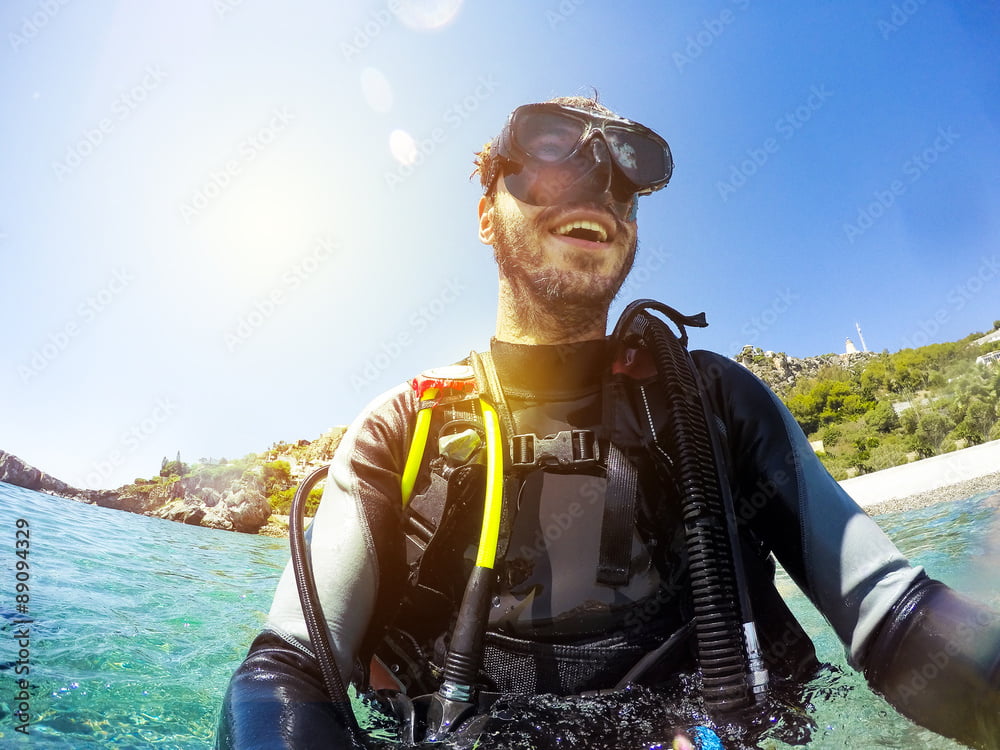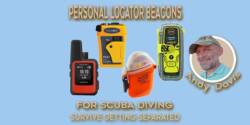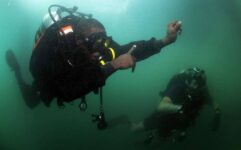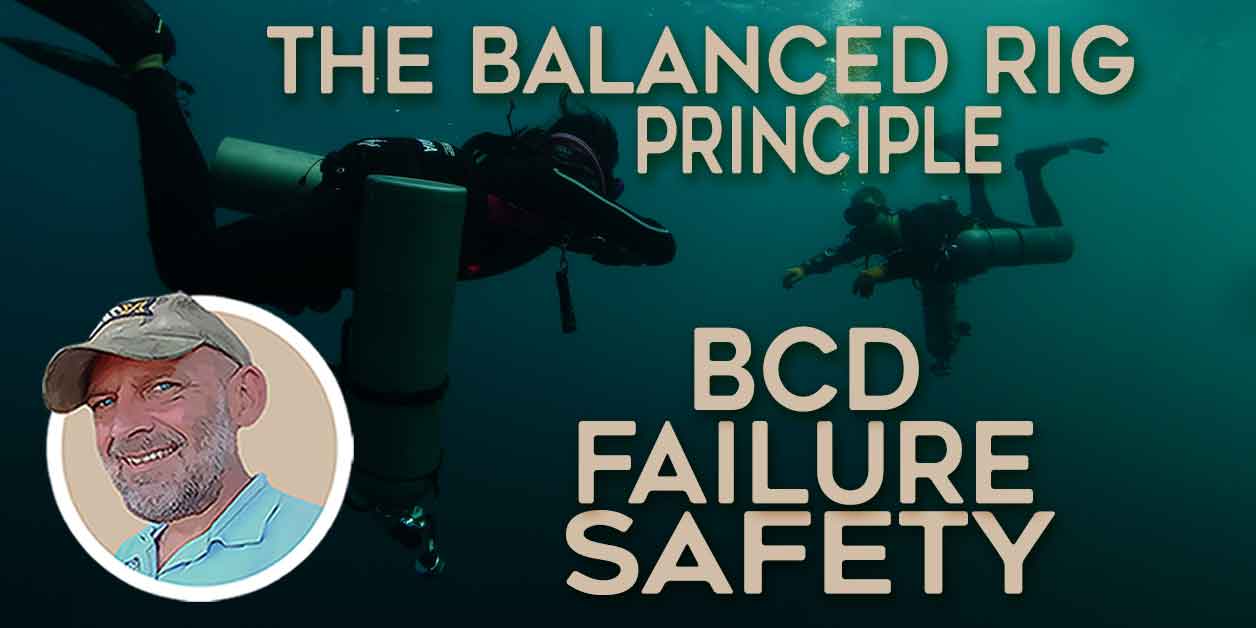The Essential Guide to Emergency Signaling Devices for Scuba Diving Safety
Scuba diving is an exhilarating and rewarding activity that allows individuals to explore the underwater world. However, like any adventure sport, it comes with potential risks. In case of an emergency, it is essential for divers to have a reliable means of signaling for help. Emergency signaling devices are crucial for scuba diving safety and can save lives.
This article explores the different types of emergency signaling devices available to scuba divers, the features to consider when choosing one, their proper use, and maintenance and storage tips.
By the end of this article, you will have a comprehensive understanding of emergency signaling devices and how to select and use them effectively during scuba diving.
Types of Emergency Signaling Devices
There are several types of emergency signaling devices that scuba divers can use to communicate with their dive buddies or to signal for help in case of an emergency. Here are some of the most commonly used types of emergency signaling devices:
- Visual Signaling Devices (VSDs):
- Dive flags
- Surface marker buoys (SMBs)
- Strobe lights
- Dive lights
- Glow sticks
- Signal mirrors
- Audible Signaling Devices (ASDs):
- Whistles
- Dive horns
- Tank bangers and Rattles
- Personal Locator Beacons (PLBs)
It’s important to note that some of these devices may serve both visual and audible signaling functions, and different types of devices may be more appropriate for different diving environments.
Visual Emergency Signaling Devices (VSDs)
Visual signaling devices are devices that produce visible signals that can be seen underwater or on the surface. They can be used to indicate a diver’s location, communicate with other divers, or signal for help. Some common types of VSDs include:
Dive Lights for emergency signaling
These are handheld lights that divers can use to signal each other or to see underwater in low-light conditions. Many modern dive lights have an emergency strobe mode. They are essential for attracting attention at night. For that reason, they should always be used in night diving.
However, if a diver gets separated and drifts at the surface, they could still be in the water after sunset. Carry a dive light on all of your dives to ensure you can be found in the dark.
Dive Flags
Dive flags are used to indicate the presence of divers in the area. They can be attached to a buoy or float on the surface and pulled around by the diver via a spool and line.
Surface Marker Buoys (SMBs)
SMBs are inflatable buoys that divers can use to signal their location to the surface. They can also indicate the end of a dive or indicate a decompression stop. SMBs are not specifically emergency signaling devices. However, they can attract attention if you are drifting in the ocean.
- Delayed Surface Marker Buoys (DSMB): Deployed when the diver is underwater.
- Safety Sausages: Only deploy at the surface.
DSMBs stand tall from the surface and are visible from long distances, depending on water conditions. They are available in different sizes, ranging from 3ft to 9ft in length.
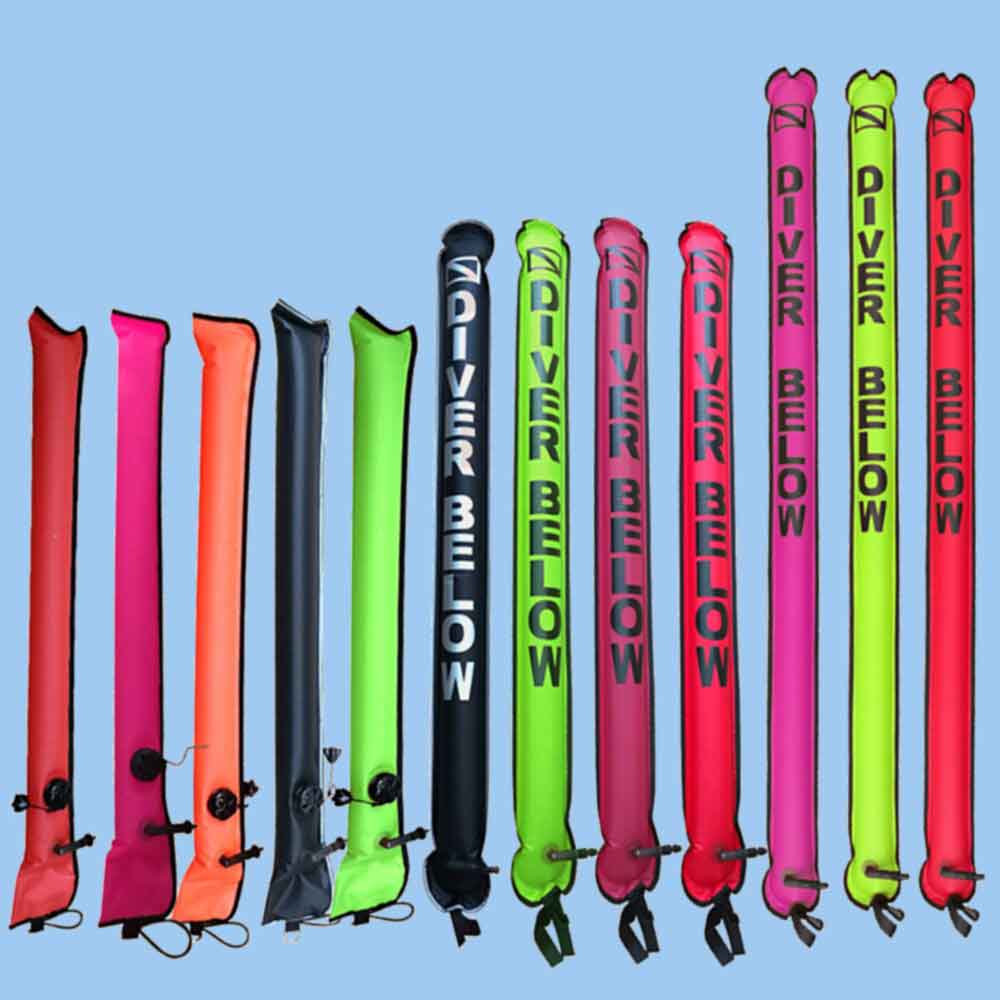
Strobe Lights
Strobe lights are flashing lights that you attach to your BCD. They are particularly useful in low-visibility conditions and the flashing pattern is effective in attracting attention.
Glow Sticks
Glow sticks are chemical lights that activate underwater or on the surface to produce a visible signal. They are lightweight, inexpensive, and ideal as backup signaling devices.
Signal Mirrors
Signal mirrors can attract attention over long ranges in sunny weather conditions. They don’t require batteries and are ready to use whenever you need them. Furthermore, they are lightweight, streamlined and easy to store in a BCD pocket.
Sea Dye Marker
Dye markers are a luminescent liquid that can be released into the water. Even a small container of dye marker can color the waterr for a 50ft area. They are primarily useful if searchers are overhead in an aircraft.
Audible Emergency Signaling Devices (ASDs)
Audible signaling devices are devices that produce sound signals underwater or on the surface. You can use them to communicate with other divers, signal for help, or attract attention. Some common types of ASDs include:
Whistles
Whistles are small, lightweight devices that divers can use to signal each other or to attract attention. They are particularly useful in low-visibility conditions.
Dive Horns
Dive horns are similar to whistles but produce a louder, more penetrating sound. They are effective over long distances. Dive horns connect to the BCD low-pressure inflator hose and use cylinder gas to make noise. They can signal an emergency underwater and at the surface.
Tank Bangers and Rattles
Tank bangers are devices that divers can use to make a loud noise by tapping their tank with a metal or plastic rod. In contrast, you shake a rattle to make a noise that attracts attention. They are useful for attracting attention or communicating with other divers in close proximity underwater.
Personal Locator Beacons (PLBs)
A Personal Locator Beacon (PLB) is a small, handheld device that can be a lifesaver if you get swept away from your boat when diving. PLBs use satellite technology to transmit a distress signal that is received by the Search and Rescue Satellite Aided Tracking (SARSAT) network.
That satellite network then tracks the location of the distress signal to alert the nearest appropriate authority, such as the coastguard or emergency services.
In the event of an emergency, all you have to do is push a button and rescuers will know your exact GPS location. You only need to register the PLB so that it is linked to you and your emergency contact phone numbers.
With prices starting at around $200, this device provides direct satellite communication and works anywhere in the world. Despite their effectiveness and affordability, few divers invest in a PLB.
A PLB is one of the most powerful pieces of safety equipment that you can buy. As such it should be considered for your dive kit whenever you do offshore diving. They are ideal for scuba divers who may be diving in remote locations or areas where there is little or no cell phone coverage.
When choosing a PLB, it is important to look for models that are specifically designed for use in scuba diving. These models are waterproof to diving depths. An alternative is to use a non-diving PLB, but store it within a robust, waterproof container when diving.
PLBs typically have a long battery life, which makes them ideal for use in emergencies. However, it is still important to regularly check and replace the batteries to ensure that the PLB is always in good working order.
Key features in a scuba diving PLB
Some of the key features to look for in a scuba diving PLB include:
- Waterproof: The PLB should be waterproof so that it can withstand the increased pressures of diving depths.
- Long battery life: The PLB should have a long battery life so that it can continue to transmit a signal for an extended period of time. 24 hours is the minimum.
- GPS-enabled: The PLB should be GPS-enabled to transmit your exact location to search and rescue authorities.
- Compact and easy to carry: The PLB should be compact and easy to carry so that it does not interfere with your diving equipment.
The pros and cons of different emergency signaling devices
Device | Pros | Cons | Cost | Range | Night/Dark |
|---|---|---|---|---|---|
Dive Lights | Can be used underwater and at the surface | Limited range, only visible in one direction | $50-500 | Medium | Yes |
Dive Flags | Easy to use and inexpensive | Have to be dragged around during dives | $20-50 | Short | No |
Surface Marker Buoys | Deployed when necessary. Easy to carry on dives | Can be obstructed by waves | $50-150 | Short | No |
Strobe Lights | Highly visible, especially in low light conditions | Short battery life, limited range | $30-200 | Medium | Yes |
Glow Sticks | Inexpensive, lightweight, no batteries required | Limited visibility, short lifespan | $5-10 | Short | Yes |
Whistles | Lightweight, easy to use, can be heard from a distance | Range depends on the strength and direction of wind | $5-20 | Short | Yes |
Dive Horns | Loud and clear, easy to use, can be heard from a distance | Complicates scuba gear and requires gas supply | $10-50 | Loud and clear, easy to use, and can be heard from a distance | Yes |
Tank Bangers | Very simple to use, can be heard from a distance | Less effective at the surface. Can be annoying to other divers | $5-20 | Short | Yes |
Personal Locator Beacons | Sends a distress signal via satellite, works anywhere | Expensive, requires registration, limited battery life | $200-400 | Long | Yes |
Features to Consider when Choosing Emergency Signaling Devices
When choosing an emergency signaling device, there are several features to consider to ensure that the device is effective and appropriate for your diving needs. Here are some important features to consider:
Visibility and Audibility
The most important feature of an emergency signaling device is its ability to be seen or heard underwater or on the surface. Look for devices that are bright, colorful, and produce a loud, distinct sound. This increases the chance of being seen or heard in an emergency situation.
Ease of Use
Choose a signaling device that is easy to use and operate, even with gloves on. Look for devices that have simple controls and are intuitive to use. Practice using your signaling device before diving to ensure that you know how to use it properly in case of an emergency.
Battery Life
Battery life is an important consideration when choosing an electronic signaling device, especially for devices that use rechargeable batteries. Look for devices that have long battery life or that can be easily replaced or recharged between dives. Make sure to check the battery life before every dive to ensure that the device is fully charged.
Size and Weight
The size and weight of an emergency signaling device can affect its ease of use and portability. Look for devices that are small, lightweight, and easy to carry in your dive bag or on your person. This will make it more convenient to carry and use in case of an emergency.
Price
Emergency signaling devices can range in price from relatively inexpensive to very expensive. While it’s important to choose a device that is high-quality and reliable, it’s also important to choose one that fits within your budget. Consider the features that are most important to you and choose a device that meets your needs and fits within your price range.
Emergency Signaling Devices for Different Scuba Diving Environments
Emergency signaling devices need to be appropriate for the specific scuba diving environment, as each presents unique challenges. It’s important to choose the appropriate emergency signaling devices for the specific scuba diving environment to ensure safety in case of an emergency.
The following are some examples of emergency signaling devices suitable for different scuba diving environments:
Open Water Diving
In open water diving, it’s important to have emergency signaling devices that can be seen from a distance, as well as heard. Examples of emergency signaling devices suitable for open-water diving include dive flags, surface marker buoys (SMBs), and whistles.
Cave and Wreck Diving
Cave and wreck diving environments are usually characterized by low visibility conditions and confined spaces. Emergency signaling devices that are suitable for these environments include dive lights, strobes, and line markers.
Night Diving
Night diving presents unique challenges in terms of emergency signaling, as visibility is significantly reduced. Emergency signaling devices suitable for night diving include strobe lights, dive lights, and glow sticks.
Drift Diving
Drift diving is when divers allow the current to carry them. When diving in areas of strong currents, it is more possible to separate from the dive boat and drift away on the surface. Consequently, you may have to signal over longer distances.
Alternatively, you might be drifting for a longer time, and need to attract attention at night. Emergency signaling devices suitable for drift diving include; PLBs, SMBs, whistles, and dive lights.
Remote Area Diving
If you are planning to go diving in remote locations, it’s important to have a reliable emergency signaling device such as a Personal Locator Beacon (PLB) in case of an emergency.
Here are some things to consider when using a PLB in a diving emergency in remote locations:
Maintenance and Storage of Emergency Signaling Devices
Proper maintenance and storage of emergency signaling devices are crucial to ensure their reliability and effectiveness when needed. Here are some tips on how to maintain and store your emergency signaling devices:
Cleaning and Drying
After each dive, rinse your emergency signaling devices with fresh water to remove any salt, sand, or debris that may have accumulated during the dive. Allow them to air dry completely before storing.
Battery Replacement and Charging
Regularly check the batteries of your emergency signaling devices and replace them as needed. It is recommended to replace batteries annually or after a certain number of dives, depending on the device.
If your emergency signaling device is rechargeable, ensure that it is fully charged before each dive. Check the manufacturer’s instructions for the recommended charging time.
Storage Conditions
Store your emergency signaling devices in a cool, dry place away from direct sunlight and extreme temperatures. Make sure that they are not stored near sharp objects or other diving equipment that may damage them.
Regular Maintenance Checks
Regularly check your emergency signaling devices for any signs of damage or wear and tear. Make sure that all components are functioning properly and that they are ready to use in case of an emergency.
By following these maintenance and storage tips, you can ensure that your emergency signaling devices are always ready for use and can help you stay safe while scuba diving.
Emergency Signaling Devices for Scuba Diving
In conclusion, emergency signaling devices are critical for scuba diving safety. Whether diving in open water, caves, wrecks, at night, or during drift diving, having the appropriate signaling device can make a difference in the event of an emergency.
When choosing an emergency signaling device, factors such as visibility and audibility, ease of use, battery life, size and weight, and price should be considered.
Additionally, it is important to properly maintain and store emergency signaling devices, including cleaning and drying, battery replacement and charging, and proper storage conditions.
By selecting and using the right emergency signaling device, scuba divers can ensure their safety and peace of mind while exploring the underwater world.
About The Author

Andy Davis is a RAID, PADI TecRec, ANDI, BSAC, and SSI-qualified independent technical diving instructor who specializes in teaching sidemount, trimix, and advanced wreck diving courses.
Currently residing in Subic Bay, Philippines; he has amassed more than 10,000 open-circuit and CCR dives over three decades of challenging diving across the globe.
Andy has published numerous diving magazine articles and designed advanced certification courses for several dive training agencies, He regularly tests and reviews new dive gear for scuba equipment manufacturers. Andy is currently writing a series of advanced diving books and creating a range of tech diving clothing and accessories.
Prior to becoming a professional technical diving educator in 2006, Andy was a commissioned officer in the Royal Air Force and has served in Iraq, Afghanistan, Belize, and Cyprus.
In 2023, Andy was named in the “Who’s Who of Sidemount” list by GUE InDepth Magazine.
Purchase my exclusive diving ebooks!
Emergency signaling devices FAQ
The best dive signaling device depends on the requirement. Lights are best in the dark. Audible devices are best in bad visibility. Electronic devices, like PRBs, are best for long ranges.
Visual signals like SMBs and DSMBs. Audible signals like whistles and air horns. Illuminates signals like lights, strobes and glowsticks. Digital beacons like PRBs.
Originally posted 2023-04-15 09:05:06.







